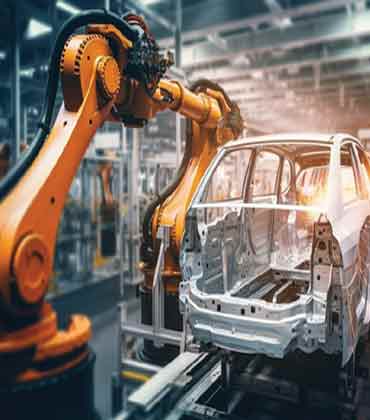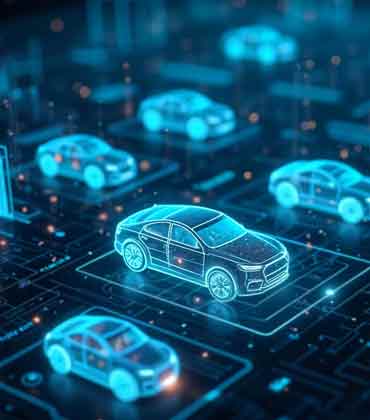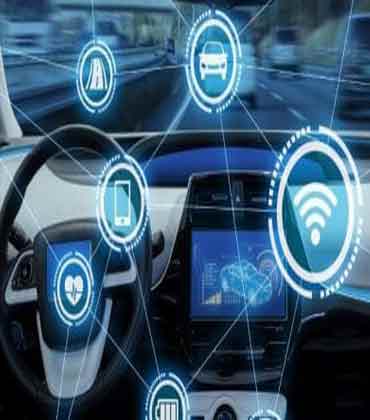Thank you for Subscribing to Auto Business Outlook Weekly Brief
Auto Business Outlook: Specials Magazine
The future of transportation is here, and it’s autonomous. Aurora Innovation is leading the way, transforming how people and goods move. It is developing selfdriving technologies that promise to make roads safer, transportation more efficient and the world more sustainable. “We are on the brink of a new era in mobility and logistics, and the excitement from the industry, our partners and customers is palpable,” said Chris Urmson, co-founder and CEO. In a world where traffic fatalities are far too common, and transportation inefficiencies are increasing, Aurora’s technology is poised to change the transportation landscape. Its vision goes far beyond creating self-driving cars, aiming to create a fully integrated ecosystem of autonomous vehicles that can navigate the roadways, freight corridors and urban streets safely and autonomously, without human intervention. The technology promises to reduce traffic accidents, improve efficiency and lower fuel consumption and emissions, paving the way for a safer, more sustainable and accessible transportation future. Advancing Autonomous Technology Founded by Chris Urmson, Sterling Anderson and James Andrew Bagnell, three experts with years of experience in the autonomous systems industry, Aurora has established itself as a major player in the race to develop autonomous vehicles. At the heart of Aurora’s technology is the Aurora Driver, a sophisticated autonomous system that enables vehicles to perceive, reason and drive safely in various environments. Two essential components—hardware and software— power the Aurora Driver to enable full autonomy. The hardware is engineered to provide precise and reliable perception of the surrounding environment. The system integrates Aurora’s FirstLight Lidar, which allows vehicles to see far ahead with unparalleled precision, detecting objects even at high speeds and in low-light conditions. High-performance cameras and radar work in tandem to provide a complete 360-degree view of the environment, ensuring the vehicle can detect and respond to obstacles, pedestrians and other road users. The computing system processes vast amounts of data in real time, allowing for split-second decision-making that enhances safety and efficiency. Designed with fail-safe mechanisms, Aurora’s hardware ensures continued operation even in the event of individual sensor failures, making the system resilient and dependable. Complementing the advanced hardware is a software stack designed to handle the complexities of autonomous navigation. The software interprets sensor data to recognize objects, anticipate their movements and predict potential hazards on the road. Using advanced AI and machine learning, the Aurora Driver calculates the safest and most efficient driving decisions in real time, ensuring smooth and predictable maneuvers. Aurora’s high-definition maps enable precise navigation, allowing autonomous vehicles to operate accurately in complex environments. The company continuously refines its technology through extensive testing—using real-world public roads and simulated environments—to improve decision-making in rare and challenging scenarios.
Software Enabled Driver Safety Solution
On a busy and cold Monday morning, Sarah was scheduled to give a promotion-worthy presentation at work when she found herself in a bit of a bind. Her sedan parked in her snowy driveway refused to start. Uncertain of what to do, Sarah rifled around her glove box and found an old motor club ID card - a program she stopped paying for years ago when she realized she never used the $100 a year service. She dialed the 1-800 number wondering if they could help and just how much it was going to cost her.
 Now imagine if Sarah had recalled the roadside assistance program she enrolled in when she renewed her auto insurance policy several years ago. She pulls up the mobile app she uses to pay her bill and immediately locates the “request roadside assistance” button on the home screen. She enters some basic information about the issue, hits submit, and almost immediately gets an estimated time-of-arrival. She tracks the service provider’s location in real-time while she waits, giving her peace of mind that help is on the way. Although Sarah required a tow due to a mechanical issue, she didn’t have to pay anything out of pocket and even received a rideshare voucher to get her to the presentation and on to that promotion!
Instead of feeling resentful and frustrated, Sarah leaves the experience with renewed appreciation for her insurance company. Not only was she reminded in the moment that she was vulnerable to vehicle issues that could impact her schedule and wallet, but was thankful her auto policy had her back – for a fraction of what she used to pay for her motor club membership.
Now imagine if Sarah had recalled the roadside assistance program she enrolled in when she renewed her auto insurance policy several years ago. She pulls up the mobile app she uses to pay her bill and immediately locates the “request roadside assistance” button on the home screen. She enters some basic information about the issue, hits submit, and almost immediately gets an estimated time-of-arrival. She tracks the service provider’s location in real-time while she waits, giving her peace of mind that help is on the way. Although Sarah required a tow due to a mechanical issue, she didn’t have to pay anything out of pocket and even received a rideshare voucher to get her to the presentation and on to that promotion!
Instead of feeling resentful and frustrated, Sarah leaves the experience with renewed appreciation for her insurance company. Not only was she reminded in the moment that she was vulnerable to vehicle issues that could impact her schedule and wallet, but was thankful her auto policy had her back – for a fraction of what she used to pay for her motor club membership.
 Customers like Sarah who used their insurance roadside coverage were 35% more likely to renew their policy and 20% less likely to shop around . Considering it can cost up to 7 to 9 times more to acquire a new customer, every renewal adds exponential value to insurance carriers’ bottom line.
The mastermind making this digital roadside experience a reality for 33,000 drivers every day and converting them to happy, loyal customers is Agero: A technology company delivering white-label digital driver assistance for the nation’s largest auto and insurance companies.
“Car breakdowns, even of a smaller magnitude, can spark big frustrations for consumers. But, an exceptional roadside assistance or accident management program will swiftly turn a driver’s day around, doubling as a customer-retention and loyalty-building tool for most automakers and insurers,” says Jeffrey Blecher, Chief Operating Officer of Agero.
[CIOS_QUOTES_REPLACE]Agero is the market leader of white-label digital driver assistance helping automakers and insurers turn breakdowns into customer satisfaction breakthroughs by assisting many like Sarah to get timely assistance during an emergency. It excels at providing prompt assistance, from resolving minor flat tire issues to major mechanical breakdowns. With a unique synergy of technological excellence and human expertise, the company holds a track record of protecting 120 million motorists and completing more than 12 million events a year.
Covering 150 client programs, Agero delivers effective solutions for all possible scenarios drivers may find themselves in – no matter what kind of vehicle, zip code, or weather pattern. Agero’s offerings are primarily classified under three key categories — Roadside Assistance, Accident Management, and Electric Vehicle Experience.
Customers like Sarah who used their insurance roadside coverage were 35% more likely to renew their policy and 20% less likely to shop around . Considering it can cost up to 7 to 9 times more to acquire a new customer, every renewal adds exponential value to insurance carriers’ bottom line.
The mastermind making this digital roadside experience a reality for 33,000 drivers every day and converting them to happy, loyal customers is Agero: A technology company delivering white-label digital driver assistance for the nation’s largest auto and insurance companies.
“Car breakdowns, even of a smaller magnitude, can spark big frustrations for consumers. But, an exceptional roadside assistance or accident management program will swiftly turn a driver’s day around, doubling as a customer-retention and loyalty-building tool for most automakers and insurers,” says Jeffrey Blecher, Chief Operating Officer of Agero.
[CIOS_QUOTES_REPLACE]Agero is the market leader of white-label digital driver assistance helping automakers and insurers turn breakdowns into customer satisfaction breakthroughs by assisting many like Sarah to get timely assistance during an emergency. It excels at providing prompt assistance, from resolving minor flat tire issues to major mechanical breakdowns. With a unique synergy of technological excellence and human expertise, the company holds a track record of protecting 120 million motorists and completing more than 12 million events a year.
Covering 150 client programs, Agero delivers effective solutions for all possible scenarios drivers may find themselves in – no matter what kind of vehicle, zip code, or weather pattern. Agero’s offerings are primarily classified under three key categories — Roadside Assistance, Accident Management, and Electric Vehicle Experience.
Golf Car Engineering Service
Evolution Electric Vehicles leads the charge in electric golf cart innovation, drawing on nearly two decades of industry expertise. Jonathan Chun, the social media marketing coordinator at Evolution, emphasizes, “Experience is invaluable—it’s earned over time. While newcomers navigate their learning curves, we stand firm on our legacy of success in the industry.” Striking a balance between quality and affordability, Evolution makes modern, eco-friendly transportation accessible to a broader audience. While many competitors focus on higher-priced models with limited features, Evolution aims to democratize access to quality lithium-battery golf carts by offering industry-leading features at the lowest prices in the market. Revolutionizing the Golf Cart Industry Evolution has quickly risen to the top of the electric golf cart industry by consistently embracing innovation and incorporating features typically found in automobiles into golf carts. Evolution was the first to introduce a touchscreen interface in a golf cart—an innovation that set a new standard in the industry. Evolution also became the first golf cart company to standardize lithium batteries across all models. Unlike traditional lead-acid batteries, which require regular maintenance and are prone to issues, lithium batteries offer enhanced reliability and longevity with minimal upkeep, all at a lower price. Arguably, Evolution’s most significant achievement was the introduction of the D5 Series, which has swiftly become the company’s flagship model. Boasting innovative features such as a 9-inch multi-function touchscreen, a sound bar, and a first-ofits-kind adjustable steering column, the D5 redefined consumers’ preconceived notions about golf carts. “Our name, Evolution, embodies the ethos of pushing the boundaries of what a golf cart can be,” notes Chun. The D5 series revolutionized consumer preferences by offering forward-facing seats, a shift from the traditional flip-flop rear kit seats. For those who prefer the traditional seating configuration, Evolution continues to offer D5 models with this arrangement, providing customers with the options they desire.
CXO INSIGHTS

Reforming Conventional Practices in the Automotive Space
Reese Blalock, Director of Automotive Technical Education and Development, AAMCO Transmissions and Total Car Care

The Revolutionary Impact of Electric Vehicles (EVs) on Automotive Suspension Technology
Mahmoodreza, Researcher, and Alireza Masrour, General Partner, Plug and Play Tech Center

Redefining the Automotive Sector with Innovative Manufacturing Systems
Trent Randles, Engineering Manager, BorgWarner

Enhancing Safety and Efficiency in Automotive Manufacturing with Advanced Inspection Technology
Brad Ward, Technical Manager (Advanced Sensing & Inspection Solutions), Omron Inspection Group

How to Stay Ahead in the Automotive Aftermarket
Aaron Shaffer, Director of Marketing Services, Standard Motor Products [NYSE: SMP]

Success Strategies for Automotive Sales
David Bailey, Senior Sales Development Manager, Edmunds

Keys to Successful Workplace Healthcare Clinics
Melissa Hubler, Senior Manager, Human Resources, Subaru of Indiana Automotive, Inc
IN FOCUS
Recent Developments Driving Innovation in the Automotive Industry
The innovations support the industry's push toward sustainability by minimizing resource consumption and emissions.
Transforming Obstacles in the Automotive Aftermarket
The automotive aftermarket faces challenges like counterfeit parts, technology shifts, supply chain disruptions, and skilled labor shortages, requiring strategic solutions.
EDITORIAL
The New Era of Automotive Aftermarket
The automotive aftermarket is going through some big changes owing to technology. From smart devices powered by the Internet of Things (IoT) to the growing popularity of electric vehicles (EVs), we’re seeing the entire industry shift toward a more connected, efficient, and eco-friendly future. Cars can now alert potential issues in real time, and in some cases, even be diagnosed or repaired remotely. That means safer, smarter driving and less stress for vehicle owners. EVs are also playing a huge part in this transformation. Reducing emissions, they’re breathing new life into older vehicles and making cleaner transportation more accessible. Advanced driver assistance systems (ADAS) are another game-changer. Features like lane-keeping assistance, automatic braking, and blind-spot monitoring—once found only in luxury vehicles are widely available, making roads safer for everyone. Then there’s customization. Thanks to technologies like 3D printing, car owners can now personalize their vehicles more easily than ever, whether it’s for performance, looks, or both. With all this innovation comes the need for collaboration. Manufacturers, regulators, and aftermarket professionals need to work together to make sure these new technologies are not only effective but also safe, secure, and sustainable. This issue of Auto Business Outlook spotlights aftermarket companies across the U.S. that are leading the way in innovation. The magazine further features valuable perspectives from industry experts including Dan Constantino, Director, Security Operations at Cox Automotive and Brendan J. Chan, Ph.D., Sr. Chief Engineer – Autonomy and Active Safety at Oshkosh Corporation. We hope these valuable insights from industry leaders featured in this edition will assist you in making informed decisions for your businesses.


![Aurora [NASDAQ: AUR]: Engineering the Next Generation of Mobility Aurora [NASDAQ: AUR]: Engineering the Next Generation of Mobility](https://www.autobusinessoutlookapac.com/newstransfer/upload/6-0b575.jpg)
![Aurora [NASDAQ: AUR]: Engineering the Next Generation of Mobility Aurora [NASDAQ: AUR]: Engineering the Next Generation of Mobility](https://www.autobusinessoutlookapac.com/newstransfer/upload/1-reh1e-.jpg)






